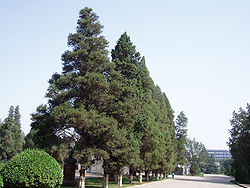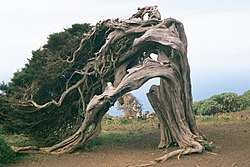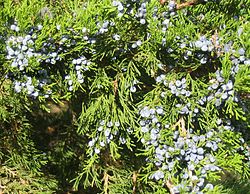Juniper
Junipers is the name for a number of species of coniferous plants in the genus Juniperus. They are related to the family Cupressaceae (the cypress). There are between 50 and 67 species of juniper. Junipers grow in the northern hemisphere.
| Juniperus | |
|---|---|

| |
| Juniperus osteosperma in Nevada | |
| Scientific classification | |
| Kingdom: | |
| Division: | |
| Class: | |
| Order: | |
| Family: | |
| Genus: | Juniperus |
Junipers are evergreen. They vary in size from low shrubs to tall trees, which grow to between twenty and forty metres tall.
Juniper berries
The female trees have seed cones. These look like a berry, and are called juniper berries. They take from six to eighteen months to grow after pollination. They are often aromatic, and can be used as a spice.
Unfortunately, the berries of some species, such as Juniperus sabina, are toxic. Eating them is not advised.[1] Juniper has a number of species, and you have to know what you are doing before you eat the berries.
Juniper Media
Detail of Juniperus chinensis shoots, with juvenile (needle-like) leaves (left), adult scale leaves, and immature male cones (right)
Juniper needles, magnified. Left, J. communis (Juniperus sect. Juniperus, needles 'jointed' at base). Right, J. chinensis (Juniperus sect. Sabina, needles merging smoothly with the stem, not jointed at base)
Juniperus grandis in the eastern Sierra Nevada, Rock Creek Canyon, California
Juniperus virginiana in October laden with ripe cones
Juniperus communis wood pieces, with a U.S. penny for scale, showing the narrow growth rings of the species
References
- ↑ Grieve, M. (1984). A Modern Herbal. Penguin. ISBN 978-0-14-046440-5.
+{{{1}}}−{{{2}}}









